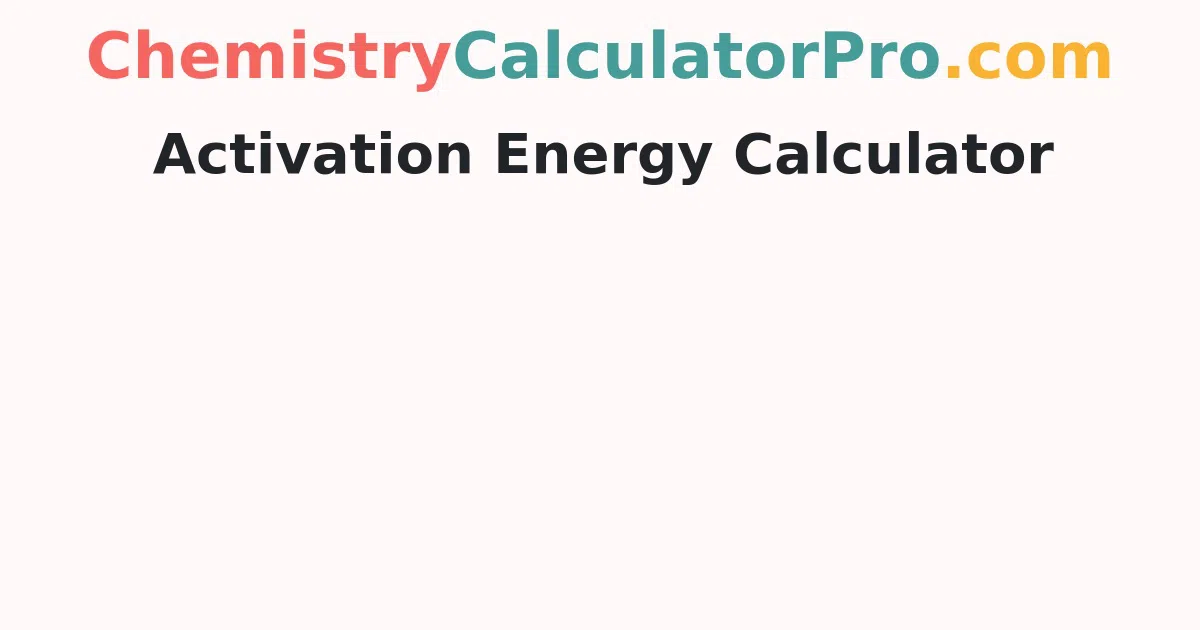Activation Energy Calculator
Use the online Activation Energy Calculator to find out how much energy is required to initiate a chemical reaction. This calculator calculates the activation energy of a reaction using the Arrhenius equation. Simply fill in the given inputs with the temperature, rate coefficient, and pre-exponential factor, then click the calculate button. The actual activation energy value, as well as the full processes, are displayed in the output section.
What does Activation Energy mean?
The smallest amount of energy required to drive atoms or molecules to undergo a chemical reaction is known as activation energy. In general, all chemical reactions require activation energy in order for the reactants to move together and begin breaking bonds. Ea is the symbol for the activation energy. It is unaffected by pressure, temperature, volume, the reactant's coefficient, or the solution's concentration.
Activation Energy Formula
The Arrhenius equation can be used to calculate the activation energy of any reaction. Eₐ = -R * T * ln(k/A)
Where,
- Eₐ = activation energy of the reaction
- R = universal gas constant = 8.314 J/(K*mol)
- T = temperature in kelvins
- The pre-exponential factor is A. This coefficient is constant for a reaction and is unaffected by temperature.
- The reaction rate coefficient k, is temperature-dependent.
How to Calculate Activation Energy?
Calculate the minimum energy necessary for a reaction by following the thorough step-by-step procedure. To acquire the outcome quickly, follow the following guiding principles and guidelines.
Step 1: The temperature, rate coefficient, and constant must all be determined.
Step 2: Calculate the universal gas constant by multiplying the temperature by the universal gas constant.
Step 3: Divide the pre-exponential factor from the reaction rate coefficient.
Step 4: Calculate the logarithm of the division above.
Step 5: To find the activation energy, multiply it by the negative of the resulting product.
How Do I Use the Activation Energy Calculator?
The activation energy calculator is used in the following way:
Step 1: Fill in the input fields with the temperature, frequency factor, and rate constant.
Step 2: To acquire the result, click the "Calculate Activation Energy" button.
Step 3: Finally, in the output field, the activation energy necessary for the atoms or molecules will be presented.
Activation Energy Examples
Question 1: If the rate coefficient is 5 1/sec, the factor is 10 M-1s-1, and the temperature is 130 K, calculate the activation energy of the chemical reaction.
Solution:
Given:
Reaction rate coefficient k = 5 sec^-1
Pre-exponential factor A = 10 s^-1
Temperature T = 130 K
Activation energy Eₐ = -R * T * ln(k/A)
= -8.134 * 130 * ln(5/10)
= -8.314 * 130 * (-0.693)
= 749.16 Joules
Hence, the activation energy is 749.16 J.
FAQs on Activation Energy
1. What is Activation Energy?
The lowest energy required for a chemical reaction to occur is known as activation energy. This energy is needed for a variety of reactions, including combustion. You must provide energy each time you want a light. That's why your matches aren't spontaneously combusting.
Joules is the SI unit for activation energy (J). Kilojoules per mole (kJ/mol) and kilocalories per mole (kcal/mol) are the other units.
2. How to find activation energy?
These steps can be used to calculate the activation energy of a reaction. Calculate the log of the value by multiplying the reaction rate coefficient by the exponential factor. Multiply it by the temperature of the gas constant. The activation energy is the product's negative.
3. Is there a link between activation energy and pressure?
This is due to an increase in the number of molecules with the bare minimum of energy. Increasing the concentration of a gas has the same effect as increasing its pressure. Catalysts can lower the activation energy and increase the reaction rate without being consumed in the reaction.
4. Is it true that a higher temperature equals lower activation energy?
The activation energy, or the minimum energy required for a process to proceed, remains constant as the temperature rises.
